|
 Hygrocybe miniceps Hygrocybe miniceps
SynonymsHygrophorus miniceps
BiostatusPresent in region - Indigenous. Endemic
Images (click to enlarge)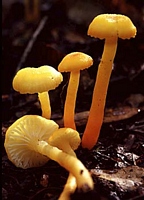
Caption: Hygrocybe miniceps
Owner: Kaimai Bush | 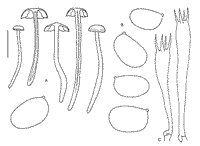
Caption: Fig. 5 Hygrocybe miniceps (Stev.) Horak (A-C: ZT 1120): A.
basidiomes.B. spores. C. basidia | 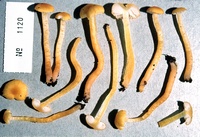
Caption: ZT1120
Owner: E. Horak: © Creative Commons Attribution-Noncommercial 3.0 New Zealand | 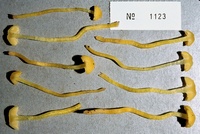
Caption: ZT1123
Owner: E. Horak: © Creative Commons Attribution-Noncommercial 3.0 New Zealand | 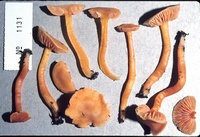
Caption: ZT1131
Owner: E. Horak: © Creative Commons Attribution-Noncommercial 3.0 New Zealand | 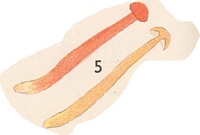 | 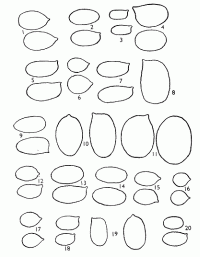
Caption: Spores X 2000 1. Hygrophorus salmonipes 2; H. elsae; 3, H .julietae; 4, H. variabilis; 5, H. lilaceo-lamelllatus; 6, H. muritaiensis; 7, H. keithgeorgei; 8, H. pseudococcineus; 9, H. rubro-carnosus; 10, H. miniceps; 11, H. procerus; 12, H. multic |
Article: Horak, E. (1990). Monograph of the New Zealand Hygrophoraceae (Agaricales). New Zealand Journal of Botany 28(3): 255-306 (http://www.rsnz.org/publish/abstracts.php).
Description: Pileus -25 mm, hemispherical to convex becoming obtusely campanulate, finally
centre flat to subdepressed; pale yellow to orange, distinct reddish tints absent;
dry, glabrous becoming minutely fibrillose to scurfy with age, hygrophanous,
margin striate, -Lamellae 8-12 (1-3) rather distant, broadly adnate-decurrent
to subemarginate, up to 7 mm wide; concolorous with pileus or paler, occasionally
pale yellowish to pallid, edges entire, obtuse. - Stipe 35-80 x 2-4 mm, cylindrical,
equal or subfusoid (with attenuated base); pale yellow-orange at apex, - orange
towards base; dry, glabrous, hollow, occasionally strigose at base, single or
caespitose. - Context pale orange in pileus, yellowish in stipe, waxy. - Odour
and taste not distinctive. - Chemical reactions on pileus: KOH - negative.
Spores (11-) 12-15 x 7-10 um, broadly ovoid. - Basidia 55-85 x 9-12 um, 4-spored.
- Cystidia absent. - Pileipellis a cutis or trichoderm of cylindrical, suberect
hyphae (8-14 um diam.), membrane not gelatinised, with yellow (KOH) encrusting
and plasmatic pigment; clamp connections present (Pl. 1, Fig. 1).
Habitat: ECOLOGY: Common; saprobic on soil among litter under Nothofagus (N. fusca,
N. menziesii), Leptospermum (L. scoparium, with Sphagnum) and in
broadleaved-conifer forest (Weinmannia,Agathis). May-June.
Distribution: DISTRIBUTION: NZ (NA, G, W).
Article: Stevenson, G. (1963) [1962]. The Agaricales of New Zealand: IV. Kew Bulletin 16(3): 373–384.
Description: Pileus 0.5-1 cm, diam., orange to scarlet, paler at edge, hemispherical, waxy
to matt; flesh orange. Gills adnate, yellow, thick, distant. Stipe 3-5 cm. X
2-4 mm., orange to scarlet above, yellow towards base, waxy, smooth, solid or
hollow, equal or thicker towards base. Spores 13-15 X 8 µm., ovoid, thin-walled,
hyaline. Basidia 80 X 8-10 µm., four-spored.
Habitat: habitat: in moss or litter under forest, Keith George Park, Wellington,
15-6-1949, Stevenson, Pinehaven, 21.6.19471 H. Druce, Levin, 18.7.1948, G. Parsons,
Collingwood, 22.2.1948, E. Kidson.
Article: Horak, E. (1971). A contribution towards the revision of the Agaricales (Fungi) from New Zealand. New Zealand Journal of Botany 9(3): 403-462 (http://www.rsnz.org/publish/abstracts.php).
Notes: Hygrophorus miniceps Stevenson (28 D) = Hygrocybe procera (Stevenson)
Horak; for discussion see there.
|